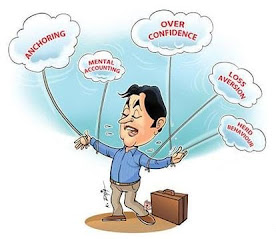Biases are our belief or irrational thinking based on certain emotions or psychological barriers at our subconscious level that prevent us to make rational decisions for our investments, often leads to poor decisions or investment mistakes.

The most common biases are:
- Anchoring Heuristic Bias: Refers to the human tendency to accept and rely on, the first piece of information received before making a decision.
- Herd Mentality Bias: Refers to investors’ tendency to follow and copy what other investors are doing instead of using their own information or making an independent decision.
- Availability Heuristic Bias: The human tendency to take a mental shortcut that relies on immediate examples that come readily to a given person's mind when evaluating a specific topic, concept, method, or decision.
- Regret Aversion Bias: The tendency of investors to refuse to admit that a poor investment decision was made. On one hand, investors tend to avoid making decisions out of fear that the decisions will turn out poorly, or on another hand, it could be an impulsive purchasing during a limited-time offer and you fear that if you don't buy them now, you may never get an opportunity like this again.
- Loss Aversion Bias: Refers to people’s preferences to avoid losing compared to gaining the equivalent amount.

- Mental Accounting Bias: The tendency of humans to develop and make decisions based on purely mental categories. Although they seem rational, the categories we create are often wholly arbitrary — and in some cases, dangerously misleading.
- Status Quo Bias: When people preference for the current state of affairs by doing nothing or by sticking with a decision made previously. The current baseline is taken as a reference point, and any change from that baseline is perceived as a loss.
- Confirmation Bias: This is the natural human tendency to seek information that confirms our existing hypothesis/understanding/view.
- Trend Chasing Bias: Investors typically run after the past performance of an investment, thinking that historical return can predict the future performance of the investments.
- Familiarity Bias: An investor always has more appetite for familiar or well-known investments. This bias prevents the investor to explore and invest in better performing investments just because they are outside his or her comfort zone.
- Self-attribution Bias: Attribute successful results to your own action but blame bad results to external factors.
- Hindsight Bias: That allows people to convince themselves after an event that they had accurately predicted it before it happened. This can lead people to conclude that they can accurately predict other events.
- Framing Bias: Occurs when people make a decision based on the way the information is presented, as opposed to just on the facts themselves. The same facts presented in two different ways can lead to people making different judgments or decisions.
- Representative Bias: When making judgments about the probability of an outcome under uncertainty. People frequently make the mistake of believing that two similar things or events are more closely correlated than they actually are.
- Optimism Bias: Causes someone to believe that they themselves are less likely to experience a negative event.
- Overconfidence Bias: A tendency to hold a false and misleading assessment of our skills, intellect, or talent. In short, it's an egotistical belief that we're better than we actually are.















No comments:
Post a Comment